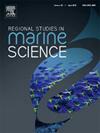对适用于葡萄牙的码头环境风险评估方法进行了批判性分析
IF 2.1
4区 环境科学与生态学
Q3 ECOLOGY
引用次数: 0
摘要
首次在葡萄牙沿海应用MERA(码头环境风险评估)程序,对26个码头的水质风险进行分类。编制了风险排名地图集,为管理人员或决策者提供有助于实现可持续发展目标的空间信息。结果表明,该国南部海岸(阿尔加维)的八个码头面临的风险最高,主要是由于航行活动的压力。然而,利用营养状况指标(TRIX和Eff)在阿尔加维沿岸产生的排名。Coeff.)基于原位水样的化学分析与MERA不一致。MERA的方法,就其现状而言,有很大的局限性。具体来说,它没有考虑到水的化学参数、沉积物污染或时间变化,而所有这些对于准确的评估都是至关重要的。为了增强MERA的稳健性,本研究建议纳入包含更广泛环境指标的其他参数和指标。本文章由计算机程序翻译,如有差异,请以英文原文为准。
A critical analysis of the marina environmental risk assessment method applied to Portugal
The MERA (Marina Environmental Risk Assessment) procedure was applied for the first time along the coast of Portugal to classify the risk of 26 marinas on water quality. A risk ranking Atlas was produced to provide managers or decision-makers with spatial information that can help achieve sustainable development goals. The results indicate that the eight marinas in the south coast of the country (Algarve) face the highest risk, primarily due to pressures from navigation activities. However, the ranking generated along the Algarve using indicators of trophic status (TRIX and Eff. Coeff.) based on chemical analysis of in-situ water samples do not align with MERA. The MERA methodology, as it stands, presents significant limitations. Specifically, it does not account for water chemical parameters, sediment contamination, or temporal variability, all of which are crucial for accurate assessments. To enhance the robustness of MERA, this study suggests incorporating additional parameters and metrics that encompass broader environmental indicators.
求助全文
通过发布文献求助,成功后即可免费获取论文全文。
去求助
来源期刊

Regional Studies in Marine Science
Agricultural and Biological Sciences-Ecology, Evolution, Behavior and Systematics
CiteScore
3.90
自引率
4.80%
发文量
336
审稿时长
69 days
期刊介绍:
REGIONAL STUDIES IN MARINE SCIENCE will publish scientifically sound papers on regional aspects of maritime and marine resources in estuaries, coastal zones, continental shelf, the seas and oceans.
 求助内容:
求助内容: 应助结果提醒方式:
应助结果提醒方式:


